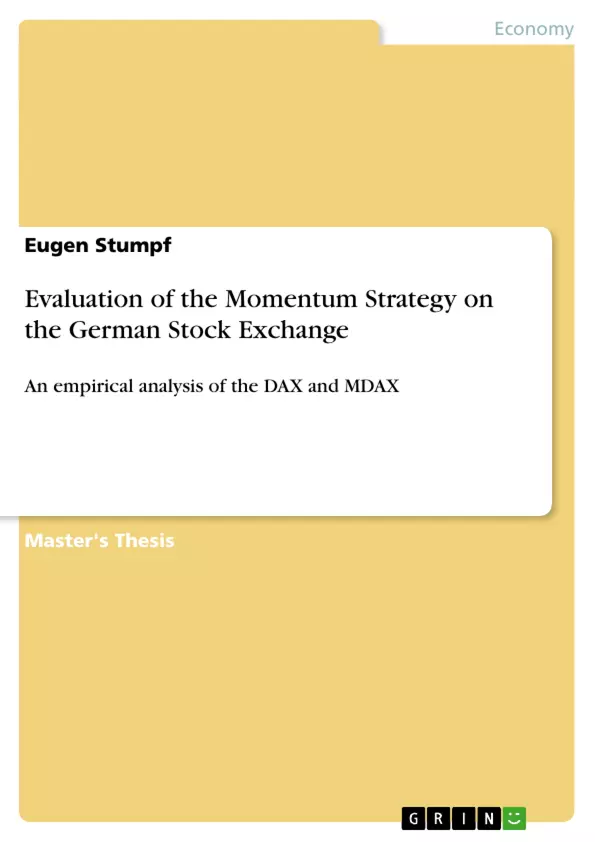This work covers the momentum effect on financial markets and a trading strategy based on this effect. The research focuses on the German Stock Exchange data from the last decade. The data are divided into two sections in order to build two different types of virtual portfolios. One section contains the data of the DAX index, and the second section is filled with securities from the MDAX. Two hypotheses are to be verified. First, is momentum still available in a time of mass internet availability, like during the past decade? And second, is momentum stronger in MDAX due to smaller firm sizes and corresponding lower market efficiency?
Inhaltsverzeichnis (Table of Contents)
- Executive Summary
- Table of Contents
- List of Abbreviations
- List of Figures
- Introduction
- Traditional Financial Market Theory vs. Newly Developed Financial Behavior Theory
- Market efficiency and "noisy inverter"
- Behavioral Finance
- Overconfidence
- Representativeness
- Other behavioral biases and models
- Momentum Effect and Momentum Strategy as Part of Market Anomalies
- CAPM and "abnormal return"
- Contrarian strategy
- Momentum strategy: initial evidence from the United States
- Empirical evidence of momentum strategy from other countries
- Data and Methodology
- Data
- Methodology
- Results
- DAX
- MDAX
- Summary
- Outlook
- Conclusion
- Appendices
- Bibliography
Zielsetzung und Themenschwerpunkte (Objectives and Key Themes)
This master's thesis investigates the momentum effect on financial markets and explores a trading strategy based on this effect. The research focuses on German Stock Exchange data from the last decade, examining the DAX and MDAX indices to test two hypotheses. First, does the momentum effect persist in an era of widespread internet access, like the past decade? Second, is momentum stronger in the MDAX due to smaller firm sizes and lower market efficiency? Key themes of the research include:- Behavioral finance and its implications for trading behavior
- Momentum effect and contrarian strategy as market anomalies
- Empirical analysis of momentum strategy on the German Stock Exchange
- Comparison of momentum performance in the DAX and MDAX indices
- The role of market efficiency and firm size in momentum effect
Zusammenfassung der Kapitel (Chapter Summaries)
The first chapter provides an overview of behavioral finance and its impact on trading behavior. The chapter introduces various biases like overconfidence, representativeness, and disposition effect, outlining their root causes and influences on trading decisions. It concludes by presenting evidence documented in several financial journals. The second chapter examines abnormal stock returns and the CAPM model. It defines and explains the background of CAPM and introduces momentum and contrarian trading strategies. The chapter delves into the momentum effect discovered by Jagadeesh and Titman (1993) and explores the contrarian strategy idea by DeBondt and Thaler (1985). Evidence supporting both trading strategies is discussed, highlighting the different time frames used: long-term for contrarian and middle-term for momentum. The third chapter describes the database and methodology used for the research. The main data is obtained from a Bloomberg terminal, covering the last decade beginning in February 2001. Data analysis is conducted using Microsoft Excel, with a VBA-based algorithm explained in detail. This chapter focuses on the portfolio construction, emphasizing the "dynamic" approach used, where securities are selected periodically based on their strength or weakness over a specific time period. The fourth chapter presents the research results, demonstrating the clear presence of the momentum effect in portfolios built on MDAX securities. Notably, portfolios with a long stock-monitoring time J and short stock-keeping time K achieve high abnormal returns, approximately 3% per month. This chapter also analyzes the t-statistic figures for the MDAX portfolio, which range from 4 to 7, aligning with the findings of Jagadeesh and Titman (1993). Conversely, the results for the DAX portfolio do not reveal a clear momentum effect, with lower t-statistic values close to 2. Furthermore, the contrarian strategy does not exhibit negative returns within a 12-month timeframe, contradicting existing literature.Schlüsselwörter (Keywords)
This master's thesis explores the momentum effect on financial markets, focusing on empirical analysis of the DAX and MDAX indices in the German Stock Exchange. Key concepts include behavioral finance, market anomalies, CAPM, momentum strategy, contrarian strategy, market efficiency, firm size, and abnormal returns. The research utilizes a dynamic portfolio construction method, comparing the performance of portfolios with different stock-monitoring and stock-keeping periods.
Ende der Leseprobe aus 92 Seiten
- nach oben
- Arbeit zitieren
- Eugen Stumpf (Autor:in), 2013, Evaluation of the Momentum Strategy on the German Stock Exchange, München, GRIN Verlag, https://www.grin.com/document/230538
Blick ins Buch



